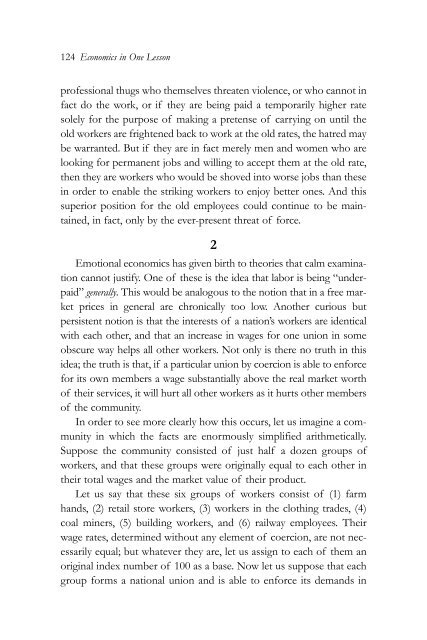1gDdM7w
1gDdM7w
1gDdM7w
- No tags were found...
Create successful ePaper yourself
Turn your PDF publications into a flip-book with our unique Google optimized e-Paper software.
124 Economics in One Lessonprofessional thugs who themselves threaten violence, or who cannot infact do the work, or if they are being paid a temporarily higher ratesolely for the purpose of making a pretense of carrying on until theold workers are frightened back to work at the old rates, the hatred maybe warranted. But if they are in fact merely men and women who arelooking for permanent jobs and willing to accept them at the old rate,then they are workers who would be shoved into worse jobs than thesein order to enable the striking workers to enjoy better ones. And thissuperior position for the old employees could continue to be maintained,in fact, only by the ever-present threat of force.2Emotional economics has given birth to theories that calm examinationcannot justify. One of these is the idea that labor is being “underpaid”generally. This would be analogous to the notion that in a free marketprices in general are chronically too low. Another curious butpersistent notion is that the interests of a nation’s workers are identicalwith each other, and that an increase in wages for one union in someobscure way helps all other workers. Not only is there no truth in thisidea; the truth is that, if a particular union by coercion is able to enforcefor its own members a wage substantially above the real market worthof their services, it will hurt all other workers as it hurts other membersof the community.In order to see more clearly how this occurs, let us imagine a communityin which the facts are enormously simplified arithmetically.Suppose the community consisted of just half a dozen groups ofworkers, and that these groups were originally equal to each other intheir total wages and the market value of their product.Let us say that these six groups of workers consist of (1) farmhands, (2) retail store workers, (3) workers in the clothing trades, (4)coal miners, (5) building workers, and (6) railway employees. Theirwage rates, determined without any element of coercion, are not necessarilyequal; but whatever they are, let us assign to each of them anoriginal index number of 100 as a base. Now let us suppose that eachgroup forms a national union and is able to enforce its demands in


